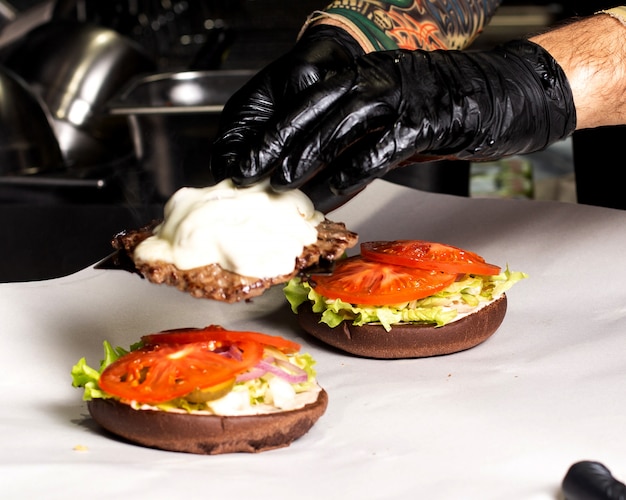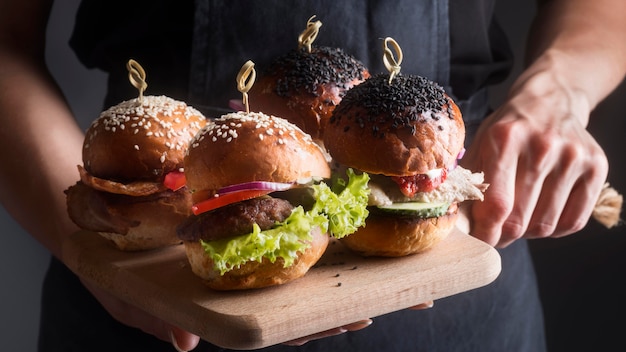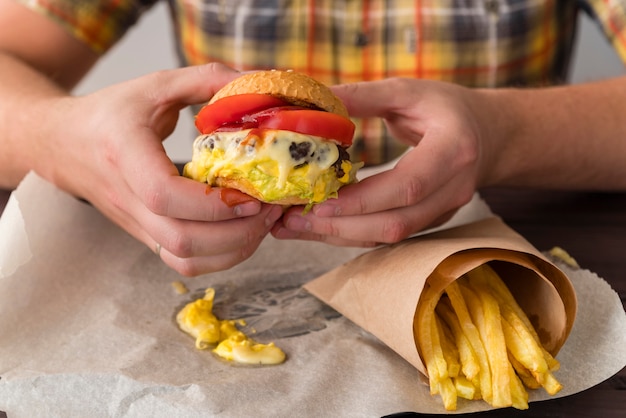Alright, let’s talk frozen burgers. You might be thinking, "Frozen burgers? They can't be as good as fresh, right?" But hold on! I'm here to tell you that you’re wrong! Frozen burgers can be just as delicious, and with a few simple tricks, you can even make them juicy and flavorful.
I've been a fan of frozen burgers for years. They were a lifesaver back in my student days. I'd pop them in the frying pan, throw on some cheese and ketchup, and bam! Quick and easy dinner. But over time, I've learned a few tricks that truly elevate the frozen burger game.
This guide is all about sharing those secrets with you, from choosing the right burger to cooking it to perfection. We'll cover everything from prepping your burger to finding the perfect toppings. So grab a cold drink, settle in, and let's get started!
(Part 1) Choosing the Right Frozen Burger

The Importance of Reading the Label: What to Look For
You're at the supermarket, staring at a wall of frozen burger packs. How do you choose the right one? The first step is to read the labels carefully.
Pay attention to:
Ingredients: Do you see anything sneaky like added fillers or mystery meats? Aim for simple, recognizable ingredients.
Meat content: The higher the percentage of meat, the better the flavor and texture. Look for at least 80% meat, and ideally, go for 100% beef.
Fat content: Fat is flavor! A little bit of fat helps keep the burger juicy and moist during cooking. Aim for a burger with at least 15% fat content.
Cooking instructions: Always read the cooking instructions on the package. This will give you a good idea of how long to cook the burger and what temperature to use.
Meat Content Matters: More Meat, More Flavor
I've learned the hard way that not all "beef" burgers are created equal. Some are mostly fillers like breadcrumbs or soy protein. These tend to be drier and less flavorful. Trust me, it's worth spending a bit extra to get a higher quality burger with a higher meat content.
Look for the Right Fat Content: Fat is Flavor
Don't shy away from fat! A little bit of fat will melt during cooking, adding richness and juiciness to your burger.
Don't Ignore the "Frozen" Factor: Fresher is Better
Frozen burgers are just like any other frozen food - the quality can vary. Look for burgers that are frozen solid and have no signs of freezer burn. This is a good indicator of freshness.
(Part 2) Prepping the Frozen Burger: Get It Ready to Cook

Thawing Frozen Burgers: The Right Way to Do It
You've chosen your perfect frozen burger, but now what? The first thing you need to do is thaw it out. Resist the urge to chuck it in the microwave or under running water. Both of those methods can ruin the texture and flavor of your burger.
The best way to thaw a frozen burger is to let it sit in the fridge overnight. It takes a bit of planning, but it's worth it for the best results.
Let's Get That Patty Ready: Pat It Dry and Season It Right
Once your burger is thawed, it's time to give it a little TLC. Gently pat it dry with paper towels to remove any excess moisture. This will help it brown evenly during cooking.
Adding Flavor: Seasoning and Marinades
Now, for a little extra flavor boost, you can season your burger before cooking. A simple sprinkle of salt and pepper is always a good start. But if you want to get creative, try a simple marinade.
Here are a few ideas:
Worcestershire sauce: Adds a savory, umami flavor.
Soy sauce: Adds a salty, savory flavor.
Olive oil, garlic powder, and onion powder: A simple and flavorful marinade.
Let the burger sit in the marinade for a few minutes before cooking.
(Part 3) Cooking the Frozen Burger: Unlocking Juicy Flavor

Grilling to Perfection: The Classic Method
Grilling is the classic way to cook a burger, and for good reason. It gives the burger a delicious smoky flavor.
Preheat: Preheat your grill to medium-high heat.
Place the patties: Place the burgers on the grill, making sure to leave some space between each patty.
Don't press down: Let it cook undisturbed for about 4-5 minutes per side, or until it's cooked to your liking. Don't press down on the burger as this will squeeze out the juices.
A cast iron pan - A Kitchen Staple: For Grill-Free Cooking
Don't have a grill? No problem! You can easily cook a great burger in a cast iron pan.
Heat the pan: Heat the pan over medium-high heat and add a little oil.
Cook the burger: Once the oil is shimmering, place the burger in the pan and cook for about 4-5 minutes per side, or until it's cooked to your liking.
The Magic of a Burger Press: Perfectly Even Patties
Want perfectly even burgers that cook evenly? A burger press is your friend. Simply place the burger in the press and press down to flatten the patty. This will prevent it from puffing up too much during cooking.
Don't Overcook Your Burger! The Key to Juiciness
One of the biggest mistakes people make when cooking frozen burgers is overcooking them. Overcooked burgers are dry, tough, and flavorless. To avoid this, use a meat thermometer to check the internal temperature of your burger.
Here are some temperature guidelines:
Rare: 125°F (52°C)
Medium-Rare: 130°F (54°C)
Medium: 140°F (60°C)
Medium-Well: 150°F (65°C)
Well-Done: 160°F (71°C)
Resting Time for juicy burgers: Let Those Juices Redistribute
Once your burger is cooked to your liking, take it off the heat and let it rest for a few minutes before serving. This will allow the juices to redistribute throughout the burger, resulting in a more flavorful and juicy burger.
(Part 4) burger toppings: The Fun Part
Classic Burger Toppings: The Tried and True
Now, it's time for the fun part - adding the toppings! There are tons of classic burger toppings, and everyone has their favorites.
Here are a few of my go-to toppings:
Cheese: Cheddar, Swiss, American, mozzarella - the choice is yours!
Lettuce: Crisp lettuce adds a refreshing crunch.
Tomato: A juicy tomato is a must-have.
Onion: Red onion, white onion, or caramelized onion - all good choices!
Pickles: Dill pickles or sweet gherkins add a tangy flavor.
Ketchup: A classic burger condiment.
Mustard: Yellow mustard or Dijon mustard - the choice is yours!
Get Creative with Burger Toppings: Beyond the Ordinary
But don't be afraid to get creative with your burger toppings! Think outside the box and try some new and unexpected flavors.
Here are a few ideas:
Bacon: crispy bacon adds a smoky, salty flavor.
Avocado: Smashed avocado adds a creamy, healthy twist.
Guacamole: A spicy and flavorful topping.
Mushrooms: Sautéed mushrooms add a savory flavor.
Roasted Peppers: Sweet and smoky roasted peppers add a delicious flavor.
caramelized onions: Sweet and savory caramelized onions are a great addition to any burger.
Salsa: Add a touch of spice and flavor.
Hot Sauce: For those who like it spicy!
(Part 5) Building the Perfect Frozen Burger: Layer Up the Flavor
The Art of Burger Assembly: A Step-by-Step Guide
Now, it's time to put it all together! Here's how I like to build my burger:
1. Start with a toasted bun: Toasted buns are a must-have for any burger! The toasting process adds a bit of crispiness and flavor to the bun. It also helps to absorb the juices from the burger, preventing the bun from becoming soggy.
2. Add your burger patty: Place the cooked burger patty on the toasted bottom bun.
3. Add your cheese: I like to add the cheese just before the burger is done cooking so it melts perfectly.
4. Add your toppings: Layer on your favorite toppings, starting with the larger items, like lettuce and tomato, and finishing with smaller items, like pickles and onions.
5. Add the top bun: Finish by adding the top bun.
The Importance of Toasted Buns: A Crispy and Flavorful Touch
Toasting your buns is a simple step that makes a big difference in the flavor and texture of your burger. You can toast them on the grill or in a pan until they're slightly crispy.
Don't Forget the Sides: Complementing Your Burger
No burger is complete without a good side dish. Here are a few of my favorite sides for burgers:
french fries: A classic burger side dish.
potato salad: A creamy and refreshing side dish.
Coleslaw: A crunchy and tangy side dish.
Onion rings: Sweet and savory onion rings are a great addition to any burger meal.
Mac and cheese: A cheesy and comforting side dish.
Salad: A lighter and healthier option.
(Part 6) FAQs about Frozen Burgers: Solving Your Burger Queries
1. How do I know if a frozen burger is cooked through?
The best way to know if a frozen burger is cooked through is to use a meat thermometer. The internal temperature of the burger should reach 160°F (71°C) for well-done, 150°F (65°C) for medium-well, 140°F (60°C) for medium, 130°F (54°C) for medium-rare, and 125°F (52°C) for rare.
2. Can I freeze a cooked frozen burger?
It's not recommended to freeze a cooked frozen burger. Freezing cooked meat can lead to a change in texture and flavor. It's best to cook your frozen burger fresh each time.
3. Can I use frozen burgers for sliders?
Absolutely! Frozen burgers are a great option for making sliders. Simply follow the same cooking instructions as you would for a regular-sized burger.
4. What are some other ways to cook a frozen burger?
Besides grilling and pan-frying, you can also bake frozen burgers in the oven. Preheat your oven to 350°F (175°C), place the burgers on a baking sheet, and bake for about 20 minutes, or until cooked through.
5. What can I do with leftover frozen burgers?
You can use leftover frozen burgers in a variety of dishes, such as:
Burger salad: Chop up the burger and add it to a salad.
Burger soup: Add the burger to a pot of soup for extra flavor and protein.
Burger tacos: Use the burger as a filling for tacos.
Burger chili: Add the burger to a pot of chili for extra meatiness.
(Part 7) Frozen burger variations: Exploring Different Options
Beyond Beef: Exploring Other Options
While beef is the classic burger choice, you can also find frozen burgers made with other meats, like chicken, turkey, or even veggie burgers.
Turkey Burgers: A Lighter Option
Turkey burgers are a great lower-fat alternative to beef burgers. They have a slightly milder flavor, so they're a good choice if you're not a big fan of beef.
Chicken Burgers: Versatile and Delicious
Chicken burgers are versatile and can be seasoned with a variety of flavors. They're great grilled, pan-fried, or baked.
Veggie Burgers: For the Plant-Based Crowd
Veggie burgers are a great option for vegetarians and vegans. They come in a variety of flavors, from classic black bean burgers to more gourmet options.
Experimenting with Flavors and Fillings: Get Creative
Once you've mastered the basics of cooking frozen burgers, don't be afraid to experiment with different flavors and fillings. Try adding different spices to your burgers, or add in some extra toppings like sauteed mushrooms or caramelized onions.
(Part 8) Freezing Your Own Burgers: A DIY Adventure
homemade burgers: Taking Control of the Ingredients
If you're feeling ambitious, you can always make your own frozen burgers at home. This gives you complete control over the ingredients and you can create your own custom flavor combinations.
The Art of Grinding Your Own Meat: Freshness and Flavor
For the best homemade burgers, it's worth investing in a meat grinder. Grinding your own meat ensures that the burger is made with fresh ingredients and no added fillers.
The Secret to a Juicy Homemade Burger: Fat Content and Additives
The key to a juicy homemade burger is to use a high-fat content meat, such as 80% lean ground beef. You can also add some fat to the meat mixture, such as ground pork or bacon.
Seasoning and Mixing: The Flavor Base
Once you've ground your meat, it's time to season it. You can use a simple blend of salt and pepper, or you can get creative and add other spices like garlic powder, onion powder, paprika, or chili powder. Mix the seasoning thoroughly with the meat mixture.
Forming the Patties: Tips for Perfect Shape
Once your meat mixture is seasoned, it's time to form the patties. Use your hands to gently shape the meat into patties. Don't overwork the meat, as this can make the burger tough. You can use a burger press to ensure that the patties are all the same size and thickness.
Freezing the Homemade Burgers: Proper Storage
Once the patties are formed, you can freeze them for later use. Place the patties on a baking sheet lined with parchment paper and freeze them for about 30 minutes. Once they're frozen solid, you can transfer them to a freezer-safe bag.
Conclusion: Frozen Burgers: A culinary gem
There you have it - a comprehensive guide to cooking frozen burgers. From choosing the right burger to adding the perfect toppings, I've shared all my secrets to making a delicious and satisfying meal.
Remember, frozen burgers are a convenient and affordable option, and with a little bit of know-how, you can easily turn them into a delicious and impressive meal. So next time you're looking for a quick and easy dinner, grab a few frozen burgers and give these tips a try. I promise you won't be disappointed!
Everyone is watching

Perfect Rice Every Time: The Ultimate Guide to Cooking Rice
Cooking TipsAs a self-proclaimed foodie, I've always been a bit obsessed with rice. It's the foundation of countless cuisi...

Prime Rib Roast Cooking Time Chart: Per Pound Guide
Cooking TipsPrime rib roast. Just the name conjures images of lavish dinners, crackling fires, and hearty laughter. It’s ...

The Ultimate Guide to Cooking Asparagus: Tips, Techniques, and Recipes
Cooking TipsAsparagus. The mere mention of this spring delicacy conjures up images of vibrant green spears, crisp and burs...

Ultimate Guide to Cooking the Perfect Thanksgiving Turkey
Cooking TipsThanksgiving. Just the word conjures up images of overflowing tables laden with delicious food, the scent of r...

How Long to Bake Potatoes in the Oven (Perfect Every Time)
Cooking TipsBaked potatoes are a staple in my kitchen. They're incredibly versatile, delicious, and surprisingly easy to m...
